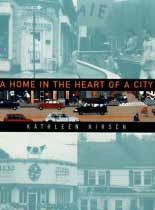Books on JP History
Please order these publications from your local neighborhood bookstore. They are also available on-line.
Jamaica Plain: Then & Now
Vintage Jamaica Plain photographs are placed alongside contemporary ones showing well-known buildings and streetscapes as they once were and as they appear today. Included are historic photographs of Jamaica Pond with its icehouses, streetcars, schools, places of worship, and homes. Anthony M. Sammarco is a noted historian and author of more than forty books on the history of Boston and surrounding cities and towns. Sammarco teaches history at the Urban College of Boston. The “Now” photograper is long-time JPHS webmaster Charlie Rosenberg
Jamaica Plain
Jamaica Plain today is one of Boston's great suburban neighborhoods, but it has not always been connected to the city. The area has a rich & colorful history that stretches from its rural, pastoral beginnings in the 17th century. JP became a part of Roxbury, and later West Roxbury, then served as a summer playground for influential Bostonians before becoming part of Boston in 1874. Today, the neighborhood is a bustling suburban spot that has preserved its natural beauty and resources. Stories abound as to how JP derived its name; some trace it to the flow of rum shipments to the port of Boston following Oliver Cromwell's seizure of Jamaica in 1660. Regardless of how the name came to be, many agree that JP is one of the loveliest areas of New England. The neighborhood's beauty was protected by such visionaries as Benjamin Bussey, who bequeathed his estate to Harvard for what is now the Arnold Arboretum, and Henry A.S. Dearborn, who established the Forest Hills Cemetery.
Orange Line

Since 1901, this rail line’s configuration has evolved in response to changes in the city, society, and technology. Hazardous sections have been eliminated, ownership has changed from private to public, and the line has been rerouted to serve growing suburbs and to use land cleared for the failed Inner Belt. Both its northern terminus, which shifted from Everett to Malden, and the southern route, realigned from Washington Street to the Southwest Corridor, have seen dramatic transformations that have in turn changed riders’ lives. Today, the line’s 10 miles of track curve through many Greater Boston communities, serving thousands along the way.
Local Attachments
This book explores the emergence of Jamaica Plain during the late nineteenth and early twentieth centuries. Like other American urban neighborhoods of the era, Jamaica Plain experienced the arrival of many ethnic groups, a house-building boom for members of every social class, and the creation of commercial, industrial, and recreational areas within its boundaries. Businesses, churches, schools, clubs, charitable societies, and political organizations spun a web of social ties that fostered a powerful sense of allegiance to the local community. Drawn from a wealth of primary sources and illustrated with more than fifty photographs and maps.
Edwina

Jill Hofstra’s book Edwina chronicles the life of a precocious and delightful girl who lived in Jamaica Plain in the early 1900s. Hofstra knew her grandmother had a passion for capturing childhood experiences and life reflections in writing. But it was not until after her death that her journals were discovered and a collection of colorful memories were revealed. Hofstra pored over the diaries of her grandmother and edited them into a compelling work that takes readers to turn-of-the-century America, where they find Edwina happily growing up on Paul Gore Street in JP. “What makes this compilation so interesting, heartwarming and entertaining are the personalities she meets, young Edwina’s open and honest approach to them and to the problems she confronts,” Hofstra writes. The journals, written as remembrances of childhood by an older Edwina, add a layer of wise perspective to the blissful unawareness of youth. She recalls how the harsh challenges of poverty and growing up Protestant in a Catholic community never seemed so bad through the filter of an optimistic young girl’s mind. Edwina also reveals what it was like growing up with a working mother - a dressmaker - and a mysterious father she barely knew.
A Home in the Heart of a City: A Woman’s Search for Community

Hirsch portrait of Jamaica Plain is full of nostalgia and soft colors. As she reconstructs the many small but vital triumphs won by zealous individuals, she also offers fascinating portraits: Eddie Ortega’s transformation from drug dealer into the 22-year-old director of the local YMCA, 73-year-old native Ruth Parker, who has known everyone in the neighborhood and who relishes, as Hirsch puts it, “the magic and the muddle of being human together.” It’s the gritty details that bring this story alive, so when Hirsch wanders off, as she often does, into philosophizing about community and her deep feelings for it, the book suffers. Before misguided urban planning led to the decline of JP, Hirsch’s mythic Jamaica Plain seems to have existed in a haze of neighborliness without abandoned stores or lots. The unanswered question is what happens next: Hirsch reports that friends in search of good public schools are leaving for the suburbs, and as she surveys the local elementary school, one is left wondering where she’ll ultimately send her young son. The energy needed to hold such a disparate community of races, cultures, economics and education together is enormous. [Publisher’s Weekly]



